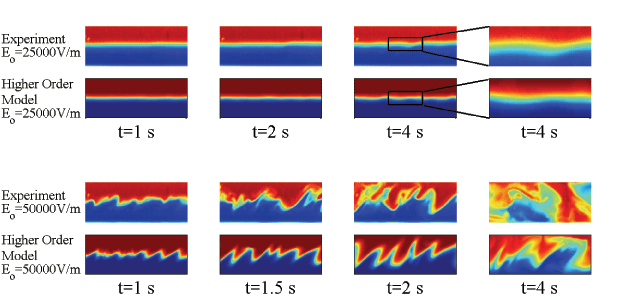
projects
fluids course
ISIM course
random old notes
hands-on school
Electrohydrodynamic instability
One active area of study is electrokinetic flows with significant electrical conductivity gradients. These flows are critical to a variety of on-chip assays such as field-amplified sample stacking (FASS) and isoelectric focusing. In these flows, the interaction of the electric field with the conductivity gradient may result in a violent instability as seen in the figure below. The figure shows comparisons between experiments and computational models (experiments were conducted by the Stanford microfluidics lab). Such instability may be desirable or undesirable, depending upon the application.
Funding: National Science Foundation, (Abstract)
Student researchers: David Boy, Nina Cary, Lee Edwards, Doug Ellwanger, Jobim Santos and Allison Schmidt.
Collaborators: Hao Lin at Rutgers University, Juan Santiago, Stanford University microfluidics lab, and Burt Tilley, Olin College.
Movies
- Depth-averaged simulation. Movie of a simulation of the electrokinetic instability using the depth-averaged equations we have developed. The upper half of the channel has a fluid with high electrical conductivity and the lower half has low conductivity. An electric field of 50,000 V/m points from left to right. The conductivity ratio is 10:1. The simulation shows good agreement with experiments. The 3D equations are integrated across the shallow depth of the channel to obtain an effective set of 2D equations that capture 3D viscous effects. Despite the turbulent appearance, the flow has low Reynolds number.
- 2D simulation. Movie of a simulation of the electrokinetic instability using 2D equations. The upper half of the channel has a fluid with high electrical conductivity and the lower half has low conductivity. An electric field of 25,000 V/m points from left to right. The conductivity ratio is 10:1. The simulated flow has some qualitative similarities to experiments, but the magnitude of the applied field is too low in the simulations. Despite the turbulent appearance, the flow has low Reynolds number.
Publications:
- Santos, J.J. & Storey, B.D., 2008 Instability of electroosmotic channel flow with streamwise conductivity gradients. Physical Review E, 78, 046316. (Full Text)
- Lin, H., Storey, B.D., & Santiago, J.G. 2008 A depth-averaged electrokinetic flow model for shallow microchannels. Journal of Fluid Mechanics, 608, 43-70. (Full Text)
- Boy, D.A. & Storey, B.D. 2007 Electrohydrodynamic instabilities in microchannels with time periodic forcing. Physical Review E 76, 026304. (Full Text)
- Storey, B.D. 2005 Direct numerical simulation of electrohydrodynamic flow instabilities in microchannels. Physica D, 211, 151-167.(Full Text)
- Storey, B.D., Tilley, B.S., Lin, H., & Santiago, J.G. 2005 Electrokinetic instabilities in thin microchannels. Physics of Fluids, 17, 18103. (Full text)
- Lin, H., Storey, B.D., Oddy, M.H., Chen, C.H. & Santiago, J.G. 2004 Instability of electrokinetic microchannel flows with conductivity gradients. Physics of Fluids, 16, 1922-1935. (Full text)
- Storey, B.D. & Boy, D. 2005 Electrohydrodynamic instability in microchannels: time dependent forcing. APS Division of Fluid Dynamics Meeting, Chicago. (Abstract)
- Lin, H., Storey, B.D., and Santiago, J.G. A depth-averaged model for electrokinetic flows in thin microchannel geometry. 2004 ASME International Congress. Anaheim, CA.
- Lin, H., Storey, B.D., Oddy, M.H., & Santiago, J.G. 2004, A Depth-Averaged Model for Electrokinetic Flows in Thin Microchannels, APS Division of Fluid Dynamics Meeting, Seattle. (Abstract)
- Hao Lin, Brian Storey, Mike Oddy, Chuan-Hua Chen, Juan Santiago 2003, Temporal electrokinetic instability and mixing in microchannels with conductivity gradients, APS Division of Fluid Dynamics Meeting, New Jersey. (Abstract)
- B.S. Tilley, B.D. Storey 2003, Three-dimensional electrokinetic instabilities in thin channels, APS Division of Fluid Dynamics Meeting, New Jersey. (Abstract)